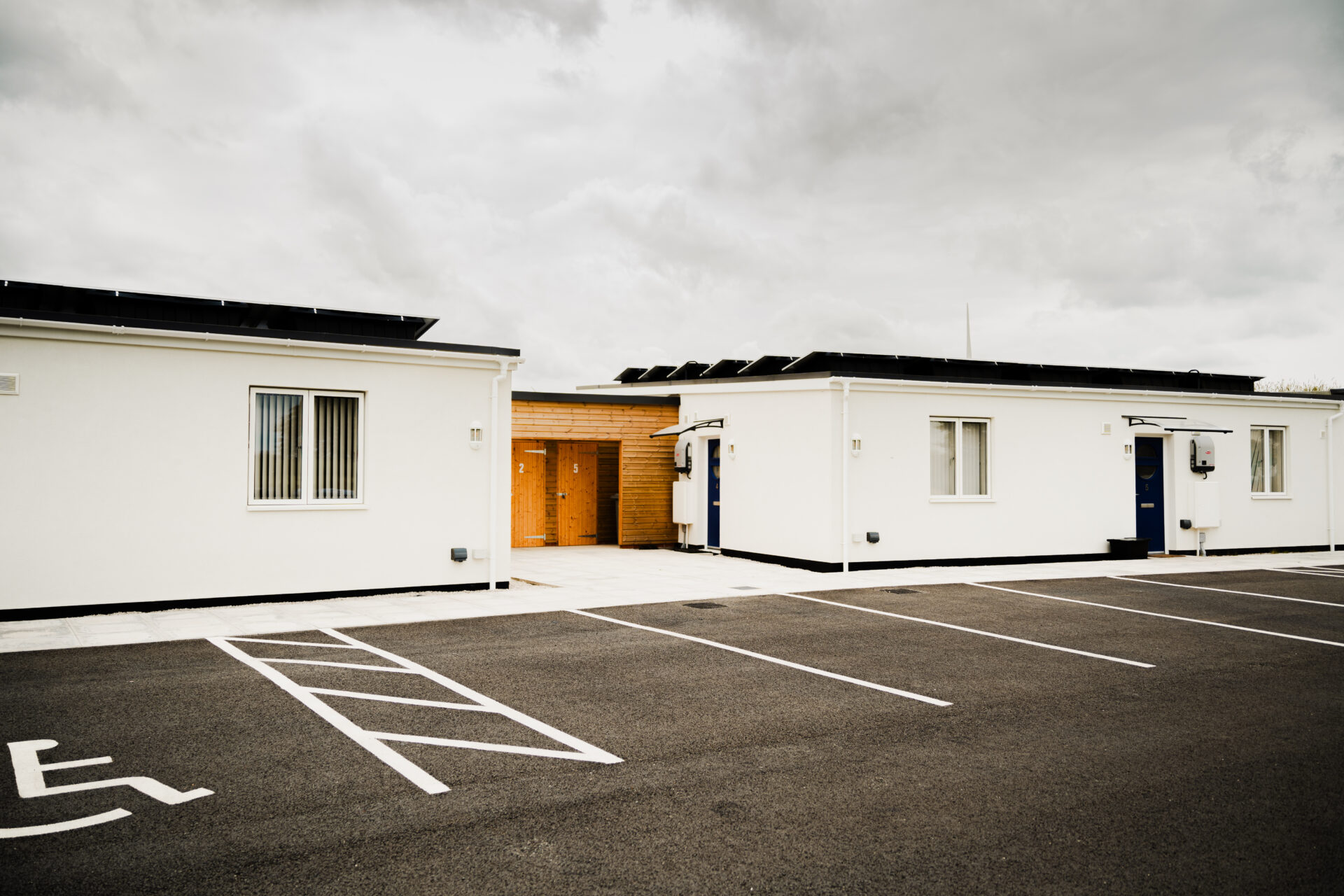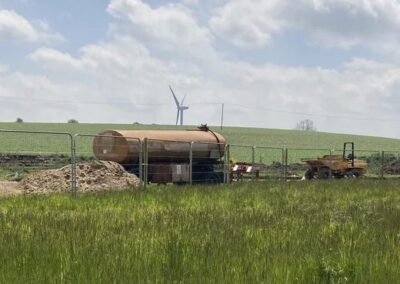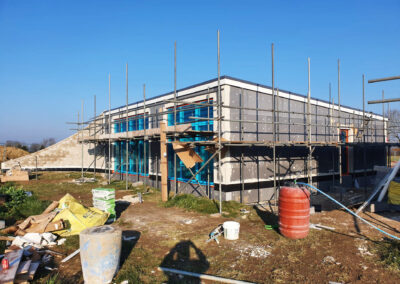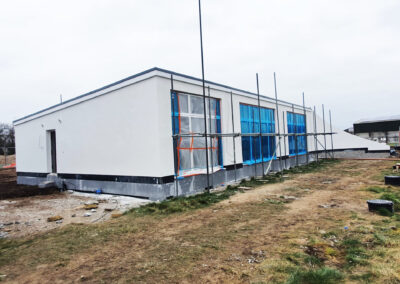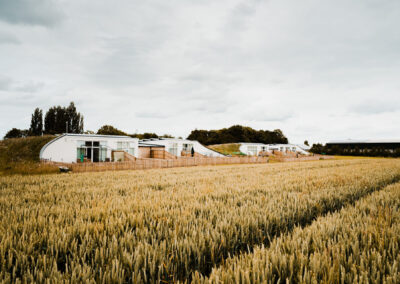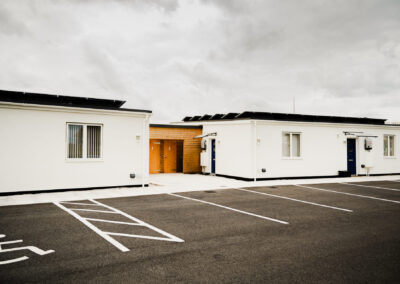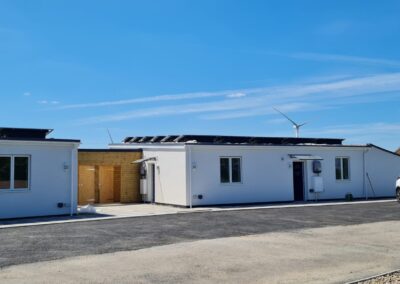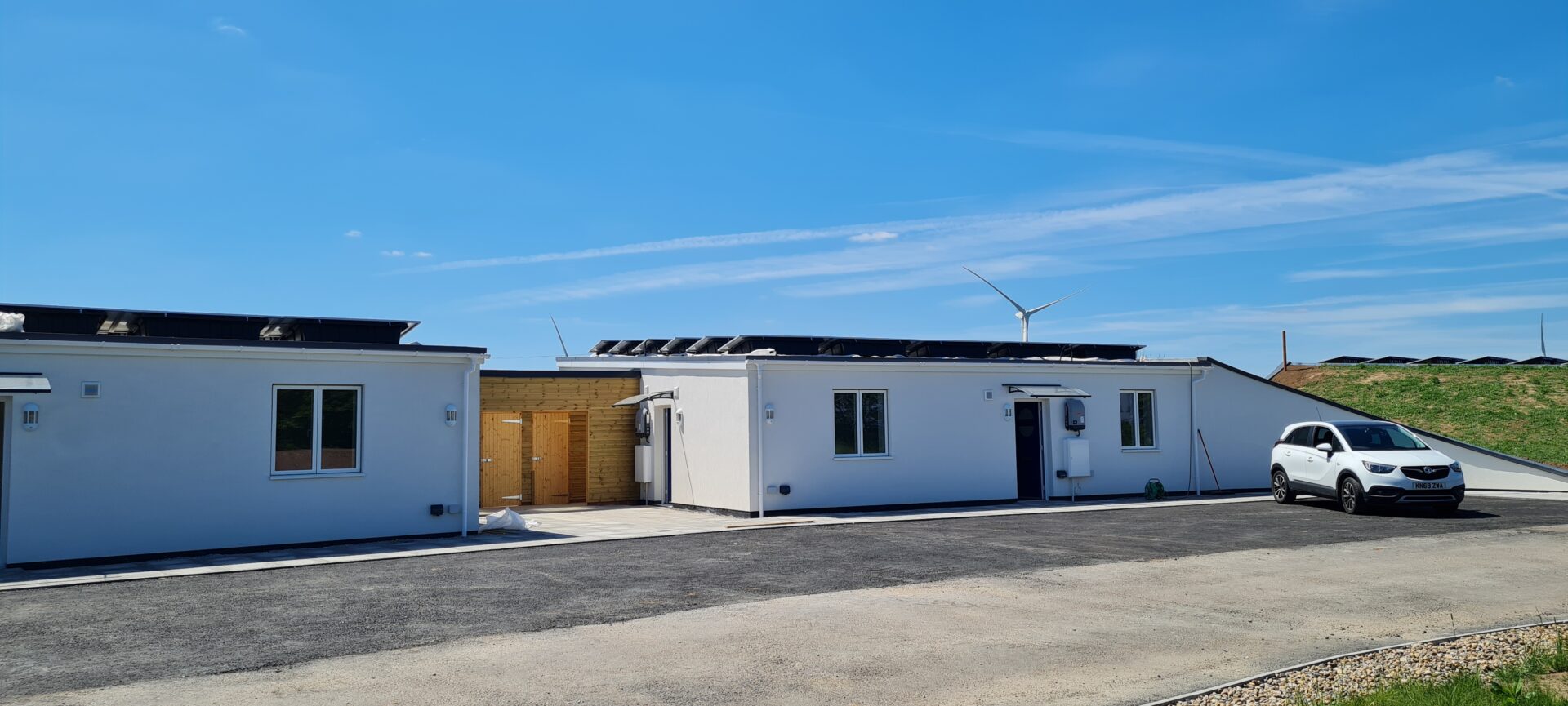INCA Case Study: Howgate Close, Nottingham
Howgate Close, Nottingham
 Project Type: New Build
Project Type: New Build
Building Type: Low Rise, Residential
System Designer: Dr Jerry Harrall
EWI System Designer: EWI Pro
Installer: Eagle Building Specialists
System & Finish: EWI Pro EPS System + Silicone Render
U-value Achieved: 0.08 W/m2k
Air Pressure Test: 0.45m (h.m ) @50Pascals
When examining the ideal staging ground for the project, the small parish of Eakring in the Newark and Sherwood District of Nottinghamshire stood out. Eakring has a storied past when it comes to oil extraction. Eakring operated Britain’s largest inland oil fields throughout its 27-year operative history. The memory of the past is immortalised with 6 restored ‘nodding donkeys’, the last of the 170 iconic structures in the Eakring area.
In 2015 Dr Parsons conceived of a replicable development solution to resolve local multifarious issues that have both national and global significance. He observed in Eakring, a shortage of affordable rural homes and a progressively diminishing biodiversity in the surrounding Nottinghamshire countryside. Dr Parsons’s model removed 10 acres from his intensive arable farm, constructed nine homes for private rent, installed 60KW of solar panels, and planted 10,000 trees and hedgerows while creating wildflower meadows, scrubland, and a wetland.
Inspiration
Dr Parsons engaged the local Hockerton Housing Project (HHP) to provide the design for ‘Howgate Close’ using the design principles applied at HHP by its Architects, Professors Brenda and Robert Vale, The Vales.
The design principles used at HHP were first published in Brenda and Robert Vale’s 1975 book, ‘The Autonomous House’ and implemented at their former Southwell home, ‘The New Autonomous House’ Over 40 years later, Vale’s design principles have been applied to Eakring’s latest additional nine dwellings, less than 7 miles from Vale’s former home. Their mission statement reflects every design principle behind the project:
“The Hockerton Housing Project is the UK’s first earth-sheltered self-sufficient ecological housing development. The residents of the five houses generate their own clean energy, harvest their own water, and recycle waste materials, causing no pollution or CO2 emissions. The houses are still amongst the most energy-efficient purpose-built dwellings in Europe.”
Passive Solar Design Techniques
The development utilises the passive solar design principles pioneered by The Vales as delivered at HHP. These design principles include:
Southerly orientation – This principle is about positioning a building and its windows to make the most of the sunlight that comes from the south in the northern hemisphere. This sunlight, particularly in winter, can be a significant source of free heat. Large windows should face south, while smaller windows face north, east, or west. Overhangs or shading devices are usually designed to block high-angle summer sun but let in low-angle winter sun. The principle of southerly orientation is essentially about optimising the building’s position to take advantage of the sun’s path throughout the day and the seasons.
High thermal mass superstructure – The concept of thermal mass refers to the ability of a material to absorb and store heat energy. High thermal mass materials include concrete, bricks, stone, and water. These materials can absorb heat during the day and release it at night, stabilising indoor temperatures throughout the day. For instance, during winter, sunlight coming through south-facing windows can be absorbed by these materials during the day, helping to warm the space, and then slowly released back into the space as it cools down at night.
Super-insulated envelope – This refers to the practice of heavily insulating the walls, roof, and floor of a building to reduce heat loss (in the winter) or heat gain (in the summer). This super-insulated envelope minimises the exchange of heat between the inside and the outside of the building, which makes it easier to maintain a comfortable temperature inside. It can include insulation in the walls, roof, and floor, as well as high-quality windows and doors, and proper sealing of all potential air leaks.
Renewable energy – While the first three principles aim to reduce the need for active heating or cooling systems, passive solar design can also be complemented with renewable energy systems to meet any remaining energy needs. These might include solar photovoltaic panels for electricity, solar water heaters, or wind turbines. The goal is to generate energy onsite, reducing the building’s reliance on the grid and non-renewable energy sources.
Planning Permission
Gaining Planning Permission 16/819/FULM for Howgate Close set a legal and planning precedent. While Newark & Sherwood District Council (NSDC) refused the 2016 planning application, it was subsequently approved on Appeal 23.01.18. In contention was the principle as to whether the development constituted isolated development in the open countryside. Appeal Inspector Mr Lyons, judged that in the light of a recent High Court decision, it did not and that the proposal offered particular benefits in terms of;
“The houses’ environmental performance and their support for the economic and social viability of the rural community, underpinned by their controlled occupancy, low running costs and restricted sales values, and by the creation of ecologically enhanced publicly accessible green space.”
The Planning Permission fits under a Section 106 Legal Agreement in which a Planning obligation will aim to balance the pressure created by the new development with improvements to the surrounding area ensuring that where possible the development would make a positive contribution to the local area and community. Given that Howgate Close provides sustainable, energy-efficient, and affordable housing for the local community, the project more than satisfies this stipulation.
The EWI system in place
The major contribution to this project on our side was the supply of materials to form the super-insulated envelope. Achieving a naturally heated, fossil-fuel-free status relies on a super-insulated fabric. Ultimately, you are trying to eliminate thermal bridges throughout the whole construction. The following products were utilised to effectively deliver this envelope that ensures that the ambient temperature of the structure sustains 22ºC +/- 2ºC.
- 230mm EPS Insulation
- EWI-225 Premium Basecoat
- Fibreglass Mesh
- EWI-076 Premium Bio Silicone Render
Impact on the community
Howgate Close has had a positive impact on the local community in several ways, encompassing environmental sustainability, biodiversity conservation, education awareness, and research.
ENVIRONMENTAL SUSTAINABILITY
The high energy efficiency within the homes has significantly reduced the overall carbon footprint, resulting in a cleaner and healthier environment for the entire community. This achievement includes a substantial decrease in energy consumption and greenhouse gas emissions.
BIODIVERSITY CONSERVATION
The planting of trees, hedgerows, and the creation of wildflower meadows, scrubland, and a pond, Howgate Close has actively promoted biodiversity within the community. This initiative has not only provided homes for various wildlife species but has also served as an inspiration for local farmers to follow suit. Residents have noticed a remarkable increase in wildlife activity, such as deer using the pond and other local wildlife thriving in the area. The scenic areas developed on the farm are now cherished by the community, offering a peaceful and safe environment for dog walkers, hikers and outdoor enthusiasts.
EDUCATION AND AWARENESS
As the development is the first of its kind in the area, it has set a precedent for future properties. The knowledge gained about renewable energy and energy efficiency can be shared with the wider community, inspiring others to adopt eco-friendly practices and promoting a commitment to sustainability. The research conducted within the properties has far-reaching benefits for the wider community and the entire UK. The knowledge and research from the project can contribute to developing long-term strategies and policies aimed at creating greener and more sustainable communities across the country.
RESEARCH
A 3-year Nottingham Trent University monitoring program at Howgate Close is co-led by Professor Anton Ianakiev (NTU) and Dr Jerry Harrall (Technical Design Consultant) to provide in-use building performance data from nine fossil-fuel-free dwellings.
Monitoring includes data from an on-site Weather Station, external and internal Relative Humidity, and temperature. Also included are internal CO2 and VOC (Volatile Organic Compounds) sensors. This dissemination of the data will inform three significant peer-reviewed Papers for journal and Conference Proceedings.
Howgate Close has achieved unprecedented high As-Built SAP (Standard Assessment Procedure) Ratings of 143A (2 bed) and 129A (1 bed) and exceptionally low Air Pressure Tests (APT) of 0.33M3(h.M2) @ 50 Pascals. EWI Pro’s role in promoting the disseminated performance data is now an active business agenda.
“How often do you turn on your heating?”
“Never. Never. The lowest temperature it’s been since we’ve been here is 19 degrees. And that was mid-winter in the morning about 7:00 am”.

